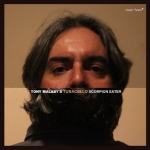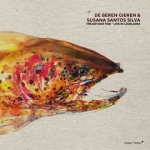 Tony Malaby’s Tubacello – Scorpion Eater (CF 318)
Tony Malaby’s Tubacello – Scorpion Eater (CF 318)
****
A acompanhar a receção crítica às suas mais inusuais formações, no jazz contemporâneo é normal impor-se um ponto que se propõe disputar a acracia que lhes é implícita e se resume nestes termos: é essencialmente subversiva ou apenas dispersiva a energia que da sua dinâmica resulta? Isto é, a insólita disposição dos seus elementos é mais uma das suas marcas de distinção ou será a única? Tony Malaby, que surge aqui à frente de um conjunto em que se une a um tubista (Dan Peck), a um violoncelista (Christopher Hoffman) e a um baterista (John Hollenbeck), e conforme se depreende pelo modo em que arruma o assunto, nunca quis tornar uma questão acessória da outra: “Há um contínuo mistério no som da tuba: de onde vem, qual a sua origem, em que lugar se situa na esfera de ação do grupo. [Possui] uma dimensão de que gosto muito.” Aliás, não seria aos 50 anos que substituiria uma convenção por outra. Na verdade, e independentemente da maneira em que se apresenta, a sua produção permanece extraordinariamente avessa a fórmulas. Quanto muito – e o título deste seu disco, só na aparência acerbo, ao inspirar-se por uma criança que adora chupa-chupas de escorpião parece apontar nesse sentido – utiliza-a para assinalar preconceitos a que jamais adere. Ou seja, não é por partilhar a instrumentação que, não há muito, Dave Douglas reuniu em “Mountain Passages” ou, há um pouco mais, e também excluindo o trompete, Arthur Blythe acomodou em “Metamorphosis”, que dos dois se irá aproximar. Até porque, acre e doce e obtusa e aguda e venenosa e sadia, esta é uma música imune ao cinismo. Simplesmente é.
Clean Radio
Archives
- April 2015
- February 2015
- January 2015
- December 2014
- November 2014
- June 2014
- May 2014
- April 2014
- March 2014
- February 2014
- January 2014
- December 2013
- November 2013
- October 2013
- September 2013
- August 2013
- July 2013
- June 2013
- May 2013
- April 2013
- March 2013
- February 2013
- January 2013
- December 2012
- November 2012
- October 2012
- September 2012
- August 2012
- July 2012
- June 2012
- May 2012
- April 2012
- March 2012
- February 2012
- January 2012
- December 2011
- November 2011
- October 2011
- September 2011
- August 2011
- July 2011
- June 2011
- May 2011
- April 2011
- March 2011
- February 2011
- January 2011
- December 2010
- November 2010
- October 2010
- September 2010
- August 2010
- July 2010
- June 2010
- May 2010
- April 2010
- March 2010
- February 2010
- January 2010
- December 2009
- November 2009
- October 2009
- September 2009
- August 2009
- July 2009
- June 2009
- May 2009
- April 2009
- March 2009
- February 2009
- January 2009
- December 2008
- November 2008
- October 2008
- September 2008
- August 2008
- July 2008
- June 2008
- May 2008
- April 2008
- March 2008
- February 2008
- January 2008
- December 2007
- November 2007
- October 2007
- September 2007
- August 2007
- July 2007
- June 2007
- May 2007
- April 2007
- March 2007
May 2024 M T W T F S S 1 2 3 4 5 6 7 8 9 10 11 12 13 14 15 16 17 18 19 20 21 22 23 24 25 26 27 28 29 30 31 Categories
Blog Stats
- 222,285 hits










